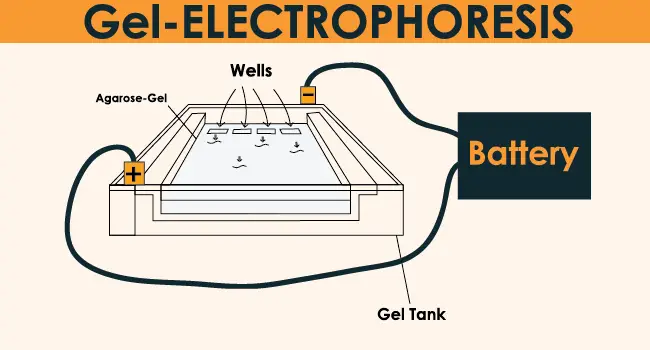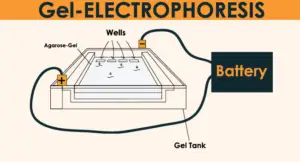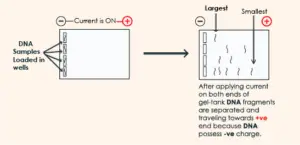
What is Gel Electrophoresis
Gel Electrophoresis is a process used to isolate/separate DNA strands from impurities in the DNA sample. This process includes agarose gel in the tank with wells and DNA samples in those wells. The current is then passed to both ends of the apparatus, which leads DNA samples to move towards the positive side.

This is a very useful process to separate DNA strands. These DNA strands are then used in pathology labs for many types of research, investigations. and detection of diseases.
Also read: Polymerase chain reaction or PCR
What is Gel Electrophoresis used for?
What is Gel Electrophoresis used for: It is a process used to get the DNA strands out from the impurities. When we get a DNA sample from an organism it also have impurities in it, so we simply ignore all those impurities and pull our DNA as pure out.
All pathology, forensic and research labs excessively use this process to get pure DNA from the samples for further research and studies. This technique always comes after polymerase chain reaction which is also a very common technique used in laboratories.
As, Polymerase Chain Reaction is used to multiply DNA copies and after this reaction there are many impurities in the DNA sample that we have to ignore (like primers, taq polymerase enzyme, and nucleotides etc ) and get our DNA strands out of them, so electrophoresis is used then.
Gel Electrophoresis Materials:
Gel Electrophoresis materials are as follow:
- Gel-Tanks
- Agarose Gel
- Battery
- DNA samples (to be processed).
- Micropipette (to transfer samples in wells)
- Gel comb.
- Stop-watch.
Gel Electrophoresis Process
Gel Electrophoresis Process does not possess any rocket science there it is a simple process which includes the following steps:
- Make agarose gel by mixing agarose powder in water and heat it. Pour the agarose solution in the gel tank with the comb placed in it and allow to cool. When it get cooled remove the comb and You will see wells are formed in the gel.
- Place Your DNA sample in the wells created by comb in the gel by using micropippete.
- Apply battery voltage on both sides of the gel tank and the DNA will start moving towards the positive pole of the battery terminal due to the negative charge on it.
- After sometime notice the distance covered by DNA strands in the gel. The smaller the DNA strand the more distance it will cover while larger the DNA strand lower distance will be covered by it.
- Separate these DNA strands and now these are ready to process further for research or any kind of investigation.

What charge DNA have
What charge does DNA have is a very logical question. There’s a pure negative charge on the DNA & this is the only reason that DNA moves towards the +ve end of the battery when we apply current on both sides of the gel tank. This -ve charge is also the reason for the existence of gel electrophoresis technique.
What are the Types of Electrophoresis
There are around 14 different types of electrophoresis which are as follow:
- Agarose-Gel Electrophoresis
- Paper Electrophoresis.
- PolyAcrylamide Gel Electrophoresis (PAGE)
- Zone Electrophoresis.
- Temperature Gradient Gel Electrophoresis & Denaturing Gradient Gel Electrophores (TGGE) & (DGGE).
- Zone Electrophoresis.
- Zymogram Electrophoresis.
- Immunoelectrophoresis.
- Pulsed-Field Electrophoresis (PFE).
- Capillary Electrophoresis.
- Fluorophore Assisted Carbohydrate Electrophoresis (FACE).
- Microchip Electrophoresis.
- Affinity Electrophoresis.
- Slab Electrophoresis.
What is Agarose Gel
What is Agarose: A polysaccharide obtained from seaweed. It is a linear polymer made with the repeating units of agarobiose. Agarose is a part of agar content that is an isolated component from agar by removing rest of the components. Agarose goes into gel form when mixed with water.
How to make agarose gel
- Measure 1-gram of agarose powder on a weighing balance.
- Now mix this powder in the 100 ml of TAE buffer in a flask.
- Heat this mixture in a microwave oven for 1-3 minutes or until the contents get properly dissolved (flask should be microwave compatible).
- Let the temperature decrease of the solution.
- Add Ethidium Bromide in the final concentration of the agarose solution.
- After achieving temperature reading of 50° pour the solution in the gel tank with well comb placed in the tank.